O F F - T H E - S H E L F
The following editorial reflects the personal
thoughts of Doug Breithaupt relating to our common hobby of miniature cars.
It is intended to generate discussion relating to 'Tales
of Toy Cars'. Your letters are welcome and may be submitted via the
'Guest Book'.
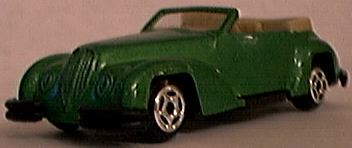 .
. .
.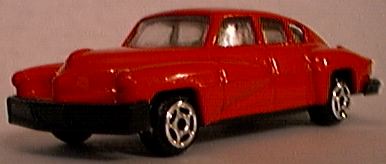 .
.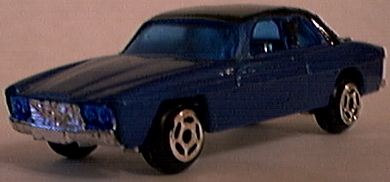
Summer Time
Do you find yourself saying, "why don't small scale diecast makers
do more of the great cars?" Someone has been listening but the source
may surprise you. The four cars shown above are distinguished by being classics
and unique castings in 1:64 scale. The manufacturer is Summer, a Chinese
firm that is best known for offering sets of about 100 diecast cars for
$7.95. They are not competing for the high-end, quality market. At the same
time, the four cars shown above represent wonderful models, un-available
from the same high-end companies. The green convertible is a 1939 Alfa Romeo
2500 Sport. The white sedan is a famous Checker cab. The red sedan is no
less than a 1948 Tucker Torpedo. The blue coupe is a 1975 Jaguar XJ12C.
Yes, the wheels are simple and Summer's curious squarish wheel cut-outs
do not improve the looks, but these are unique castings. They have windows
and full interiors. With a bit of paint detailing, they could become quite
distinctive. The Alfa, Checker and Tucker were recently purchased in Canada,
at an exchange-bonus price of about $.40 each. The Jaguar is older and shows
that Summer has provided these unique castings for some time. The source
of these interesting castings seems to be from 1:43-1:36 scale diecast.
I suspect that Summer uses 1:43 and 1:36 scale diecast as a source for their
models designs. Many other diecast manufacturers use other diecast or plastic
kits as a model for their offerings in bigger or smaller scales. This is
a legitimate practice and should not be confused with cheap copies of same-scale
cars from other companies. The inspiration for the Alfa was clearly Solido's
1:43 scale 2500 Sport, #4160. The Jaguar may have come from Corgi's 1:36
scale XJ12C. The Checker and Tucker can also be found in 1:43 scale.
For the collector, these are quite charming little models, especially
at less than $.50 each. Maybe Summer will finally provide me with a BMW
507, a Maserati Ghibli, a Bentley Continental, a Studebaker Avanti and so
many more missing from 1:64 scale. More hot rods, muscle cars and NASCAR
racers seem to be the fixation of most major diecast manufacturers. Finding
unique models like the ones above are as refreshing as a Summer breeze.
Excalibur Deux
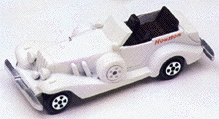
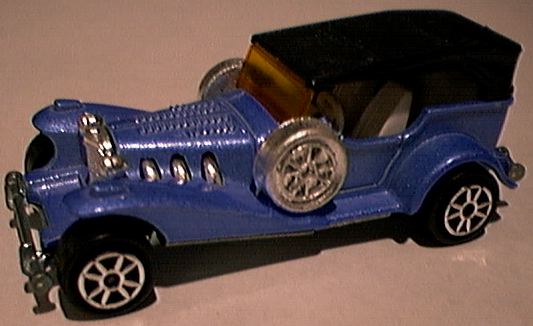 As noted in the Ertl
article contained in this issue, Mike Condon of Australia was kind enough
to send me a variety of images from Ertl's 1982 Catalog. An earlier
Ertl article provides a detailed look at these cars. One of the more
interesting offerings was an Excalibur Phaeton in series III bodywork. This
make for an interesting comparison with the series II Excalibur by Majorette,
recently featured in ToTC. The Ertl version was offered as part of a Matt
Houston TV show collection of four vehicles (the other three were the 1970
Cadillac Cvt., Maserati Quattroporte and Chevy Blazer). I had thought that
the Majorette casting was the only small-scale Excalibur but Mike has shown
me the error of my ways. Now I have another car to put on my 'seeking' list.
Many would say that the original Excalibur designed by Brook Stevens with
Studebaker power, was the best looking. Unfortunately, it has not been done
in 1:64 scale yet. Many enthusiasts do not find these neo-classics appealing
and from a design stand-point, I must agree. At the same time they deserve
a foot-note in automotive history and toy car history as well. Thanks. Mike.
As noted in the Ertl
article contained in this issue, Mike Condon of Australia was kind enough
to send me a variety of images from Ertl's 1982 Catalog. An earlier
Ertl article provides a detailed look at these cars. One of the more
interesting offerings was an Excalibur Phaeton in series III bodywork. This
make for an interesting comparison with the series II Excalibur by Majorette,
recently featured in ToTC. The Ertl version was offered as part of a Matt
Houston TV show collection of four vehicles (the other three were the 1970
Cadillac Cvt., Maserati Quattroporte and Chevy Blazer). I had thought that
the Majorette casting was the only small-scale Excalibur but Mike has shown
me the error of my ways. Now I have another car to put on my 'seeking' list.
Many would say that the original Excalibur designed by Brook Stevens with
Studebaker power, was the best looking. Unfortunately, it has not been done
in 1:64 scale yet. Many enthusiasts do not find these neo-classics appealing
and from a design stand-point, I must agree. At the same time they deserve
a foot-note in automotive history and toy car history as well. Thanks. Mike.
Menage a Corvette
My previous article on Corvette C3 models
in 1:64 scale raised an interesting point for readers regarding the Matchbox
casting. You tell me, what's wrong with these three pictures? The same car,
with and without t-tops is labeled as a '74, '77 and then '78 Corvette.
What gives? The easy answer is that Matchbox has found it easy to play fast
and loose with the model year represented by this casting. Curiously, it
is the casting represented by the '77 example that came first and is most
likely the correct year. The model was released by Matchbox in 1979 and
was one of the last of the Lesney castings made in England. As it has the
notch-back styling of the '68-'77 cars and came out in '79, it was most
likely modeled from the '77 car. In 1993, Matchbox offered a boxed set of
five Corvettes to celebrate the 40th anniversary of America's sports car.
The two yellow-boxed cars come from this set. The t-top version of the '77
C3 has suddenly become a '74. I don't know if t-tops were available for
the Corvette in '74 but Matchbox obviously thought so. The other casting
change is the addition of wing windows. This is strange as the wing window
on Corvettes was deleted in 1968! Did Matchbox need the extra support for
the 'A' pillar when the t-tops were cut out? More recently, the same t-topped
car has appeared in the Premier Collection as a '78. Of course in 1978,
Corvette went to a fast-back window so this is an obvious error in year.
Why not call it a '77 as it clearly is? Matchbox is not the only diecast
maker to play around with model years. This example may however be the most
extreme.
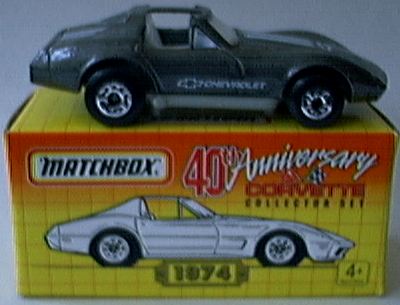 .
.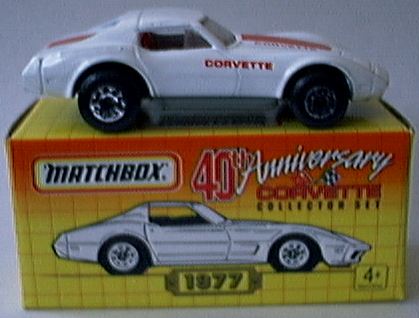 .
.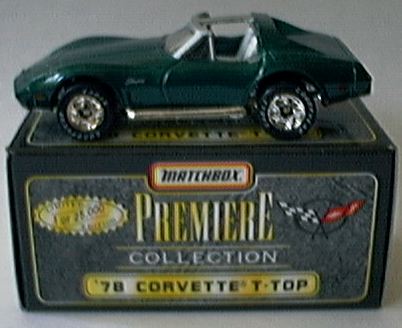
Editor's note: Please tell me about your diecast interests and why you
collect. I would love to share your story with 'Tales
of Toy Cars' readers. Your contribution may be submitted via the 'Guest Book'.

 As noted in the Ertl
article contained in this issue, Mike Condon of Australia was kind enough
to send me a variety of images from Ertl's 1982 Catalog. An earlier
Ertl article provides a detailed look at these cars. One of the more
interesting offerings was an Excalibur Phaeton in series III bodywork. This
make for an interesting comparison with the series II Excalibur by Majorette,
recently featured in ToTC. The Ertl version was offered as part of a Matt
Houston TV show collection of four vehicles (the other three were the 1970
Cadillac Cvt., Maserati Quattroporte and Chevy Blazer). I had thought that
the Majorette casting was the only small-scale Excalibur but Mike has shown
me the error of my ways. Now I have another car to put on my 'seeking' list.
Many would say that the original Excalibur designed by Brook Stevens with
Studebaker power, was the best looking. Unfortunately, it has not been done
in 1:64 scale yet. Many enthusiasts do not find these neo-classics appealing
and from a design stand-point, I must agree. At the same time they deserve
a foot-note in automotive history and toy car history as well. Thanks. Mike.
As noted in the Ertl
article contained in this issue, Mike Condon of Australia was kind enough
to send me a variety of images from Ertl's 1982 Catalog. An earlier
Ertl article provides a detailed look at these cars. One of the more
interesting offerings was an Excalibur Phaeton in series III bodywork. This
make for an interesting comparison with the series II Excalibur by Majorette,
recently featured in ToTC. The Ertl version was offered as part of a Matt
Houston TV show collection of four vehicles (the other three were the 1970
Cadillac Cvt., Maserati Quattroporte and Chevy Blazer). I had thought that
the Majorette casting was the only small-scale Excalibur but Mike has shown
me the error of my ways. Now I have another car to put on my 'seeking' list.
Many would say that the original Excalibur designed by Brook Stevens with
Studebaker power, was the best looking. Unfortunately, it has not been done
in 1:64 scale yet. Many enthusiasts do not find these neo-classics appealing
and from a design stand-point, I must agree. At the same time they deserve
a foot-note in automotive history and toy car history as well. Thanks. Mike. .
. .
. .
.
 .
. .
.